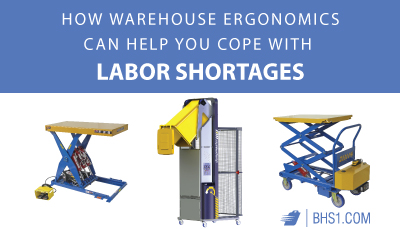We use cookies to make your experience better. To comply with the new e-Privacy directive, we need to ask for your consent to set the cookies. Learn more.
How Warehouse Ergonomics Can Help You Cope with Labor Shortages
The logistics and warehousing industries are facing substantial labor shortages. A 2015 study presented at the Council of Supply Chain Management Professionals (CSCMP) conference showed issues with labor availability throughout the sectors; however, the CSCMP's 2018 survey noted that the vast majority of 3PL professionals agreed upon an increased need "to respond to customers more quickly and with complete, accurate, and consistent information."
In other words: Labor shortages will occur, but they can't slow down your operation. In the warehouse, even a temporary labor shortage can have drastic effects, and while they're a standard part of doing business, successful managers should know how to work through them.
Of course, that's easier said than done. According to the Third-Party Logistics Study, 61 percent of respondents reported a "lack of continuity and thus quality of service or product" as a result of shortages. Unsurprisingly, that frequently meant substantial decreases in productivity and output; many managers reported settling into a "low-skill" equilibrium, while about a third reported more safety concerns, likely due to undertrained workers taking on more and more tasks.
Ergonomic Equipment Can Reduce the Consequences of Work Shortages
Ergonomics is the science of optimizing equipment to reduce strain on human bodies, but it's also the science of efficiency: When properly implemented, an ergonomic piece of equipment will allow a worker to quickly complete a task without sacrificing workplace safety.

This can benefit a short-staffed warehouse in several ways:
-
Workers can move more efficiently.
BHS Tilt Tables and Scissor Lift Tables, for instance, position loads at comfortable working heights and angles, allowing workers to optimally position their work. They're able to quickly process SKUs, and since the equipment is truly ergonomic, each worker benefits regardless of body type or size. Numerous tabletop options and other customizations are available.During a labor shortage, efficiency becomes critical, and employees may have to work extra hours, which adds greatly to operational expenses. A few pieces of relatively inexpensive equipment can make an enormous difference.
-
Ergonomic equipment can allow workers to handle different types of tasks.
Products like BHS's Powered Mobile Tilt Tables and BHS Bin Dumpers provide powerful solutions for certain operations, allowing workers to handle more complex or labor-intensive tasks without risking injury.
-
Fewer injuries limits labor shortages.
OSHA reports that work-related musculoskeletal disorders (MSDs) are "among the most frequently reported causes of lost or restricted work time."When labor is already in short supply, limiting injuries should be a priority. Ergonomic equipment reduces musculoskeletal strain, allowing workers to handle repetitive tasks without subjecting their bodies to fatigue (and eventually, injury).
There is, however, one problem with using ergonomic equipment to reduce the effects of a warehouse labor shortage: To enjoy the maximum benefits, managers need to buy equipment before serious shortages occur. Training is essential, and ergonomic products should be carefully chosen to account for your operation's unique characteristics. BHS equipment is designed to accommodate different types of warehouse workplace tasks, and intuitive ergonomic designs ensure easy integration.
By training workers on new, efficient equipment, you can create a more flexible workforce—and handle the occasional labor issue while staying competitive.
References:
"2015 Third-Party Logistics Study." 3PLStudy. C. John Langley, Jr., Ph.D., 2015. Web. 29 Sept. 2017.
"Ergonomics." OSHA. Occupational Safety and Health Administration, U.S. Department of Labor, n.d. Web. 29 Sept. 2017.
"Warehouse and Logistics Sectors are Struggling With Worker Shortage." Datamark. Datamark, 7 Oct. 2015. Web. 29 Sept. 2017.
